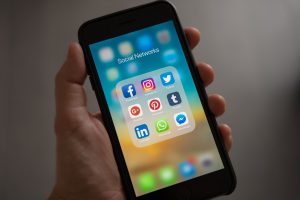Users or Used?
In Goethe’s “The Sorcerer’s Apprentice”, a young novice finds a way to bewitch inanimate objects – dusting brooms – to complete menial tasks for him and independently increase their number to perform these tasks quicker and quicker. What sets out making the apprentice’s life significantly easier quickly begins to overwhelm him; he realizes he has lost control over what these apparitions do as they quite literally begin to drown him in his study. Lamenting the situation spiralling out of control, he exclaims “these apparitions I called to my aid/ I now cannot again dismiss”. In a way, new media has become this ghost of modern times that modern society has called to our aid, which we increasingly losing control over. New Media is ubiquitous in modern day life, facilitating communication and the spread of information in virtually every part of the world and most aspects of our lives. The possibilities are tremendous – information has never been as accessible to as large of the global population as ever before and digital platforms enable anyone with access to put their messages out there, at least in principle. Video sharing further minimizes language barriers, information is less aggregated by singular sources that are perceived to be bound by certain ideologies and practically anything can be shared and make its way across the globe within minutes.
The potential of such forms of communication are not lost to entities that aim to promote change in wider contexts. In the humanitarian and development sector, the capacity of new media to be produced and received by target audience in a vast scope is recognized to be of immense value and potential. Making use of these platforms comes with a host of challenges, however, some of which have proven in the last two decades to pose sizeable risks when it comes to the extent to which such platforms are useful versus how much they use the people on their platforms. Power over what is communicated is increasingly shifted not only from the designing organization, but also from the users of these platforms who are being manipulated by these media formats to ends they do not intend. The reliability of content shared online does not positively correlate with its popularity, resulting in a threat of misinformation running amok on such platforms with little or no way for external organisations or individuals to curate it. In fact, letting misinformation run its course or, worse yet, capitalising on it have proven to be effective business models.

New Currency: Attention
To understand the nature of how new media platforms interact with their users and how relationship with truthfulness is constructed, it is imperative to situate the ascribed value of interactions on these platforms. It is the cry of every TikTok video published, the goal of every humanitarian campaign, the success criteria development campaigns are measured in. In short, “Attention is oxygen for movements.” (Tufekci, p.30). The dynamics of attention in new media “are significant social mechanisms, especially for social movements, since they change the operation of a key resource: attention” (Ibid, p.30). As such, the user is placed in the position not of the client, but of the product. Media platforms are as much in the business of serving us (content) as they are exploiting the user’s attention to content published. At the most basic level, the enterprises that own these platforms need to generate profit. Time/attention spent on these platforms translates directly into profit; it is therefore in the highest interest of these platforms to maximize our time spent on the platforms and minimize our time off it.
It is therefore prudent to “think of attention as a resource allocated and acquired on local, national, and transnational scales, and censorship as a broad term for denial of attention through multiple means, including, but not limited to, the traditional definition of censorship as an effort to actively block information from getting out” (An Xiao Mina, 2013). People thus engage with these platforms with the assumption that the platforms work for them; in reality, they are engaging in systems “where the audience barely recognises they are engaging in labour, but create economic value. Users become part of the ‘attention economy’, because they need to pay, receive and seek the attention of others to amplify content and succeed” (Fuchs & Trottier 2013, p34). If attention can be understood to be synonymous with profit for new media platforms, then the ‘users’ of such platforms are the cattle being milked for it.
Research has already indicated which various parameters are taken into consideration to facilitate this attention grab. Most basically, knowing the user well means knowing what to dish up to him/her to ensure continued attention. A user is profiled based on these preferences and grouped with others of similar tendencies to better tailor content they are exposed to. Interestingly, “new data technologies tend to sort, profile and inform action based on group rather than individual characteristics and behaviour” (Taylor et al., 2017), showing how the status of the individual is further diminished for the marketability of the groups they can be assigned to. Consent for data to be harvested is mostly given easily and without thought, allowing platforms to gather up to 52,000 data points on their users without them even noticing it (Wright 2018). This, already, opens an ethical grey zone of how much of our data platforms are allowed to harvest. While media platforms require the explicit consent of users to collect and use data, the terms and conditions are rarely understood (or read) to their fullest extent and usage of these platforms is pervasive – a person may arguably incur severe drawbacks from not being on these platforms and is therefore pressured to accept terms regardless of what they state.

Mainting Control?
Content posted online does not typically adhere to the intent of those that wish to steer it. In fact, a study by the University of Indiana and the Shanghai Institute of Technology (Menczer & Hills, 2020) has shown that there is a direct correlation between the amount of false information and the popularity of such false information. In other words, there more lies there are, the more these lies are preferred over the truth. Coupled with people’s tendency to seek out narratives that are reproductions of their own, the slippery slope to misinformation is all but given. Homophily, which is defined as the phenomena of people seeking out or being attracted to those that share their own opinion (McPherson, Smith-Lovin, & Cook, 2001), plays an important role in how information is reproduced digitally. In an arena where physical distance is no longer a factor for the ability to spread news, social media platforms can connect thousands of people in the shortest spaces of time and create strong – and vast – in groups of people that reaffirm each others’ beliefs with no regard to the factuality of these beliefs.
Another important consideration to keep in mind when researching and applying conjecture on the nature of how we interact with social media and it on us is its relative novelty. New media platforms – as the name already suggests – are new: facebook was founded in 2004, Instagram in 2010, TikTok in 2016 (Tufekci, p30). In these years, they have emerged out of obscurity to being the primary platforms for social interaction for billions of people. Doubtlessly, the way we interact on and with these platforms has and continues to be studied minutely. Yet, it may serve well to remind ourselves that virtually none of these platforms in popular use today were even around two decades ago, meaning that even the longest and oldest studies still only catch a glimpse of what these platforms continue to do with us and how they will continue to evolve. Popular and widespread received attempts at educating the global populace on the dangers and manipulative nature of these networks are also fairly recent, such as the Netflix documentary “The Social Dilemma”(Orlowski 2020), which effectively laid bare the crux of the issue of being reliant on media platforms that are, ultimately, private enterprises. The legal boundaries within which they are allowed to act are blurry at best, with restrictions to privacy rarely transparent and overreaching use of private data for profit ubiquitous. Similarly, the short video sharing service TikTok i spart part of a $150 billion global business (Iqbal, 2022), it would be a mistake to mistake this seemingly ditsy media platform for anything other than what it is – a business enterprise that capitalizes on the attention of millions of users.
With this for-profit model that at best tolerates ethical boundaries, media platforms often cater to negative parts of the human psyche, such as reinforcing biases and toxic in-group feelings, capitalizing on our morbid curiosity and desire to witness suffering, and preying on feelings of insecurity. Previously mentioned examples from other blog posts include facebook suggesting posts that are designed to align with users’ previously held convictions, reinforcing what they already believe with no regard for the reliability of such beliefs (Confessore 2018), or TikTok videos making money off of refugees and those affected by war by monetizing engagement with people begging online (Gelbart, Akbiek, & Al-Qattan. These examples shine light on a questionable ethics at work within the nature of these platforms and how they engage their audience, often catering to qualities and curiosities that would be shunned within most societies such as ignorance and morbid curiosity. In the greater scheme of these platforms, if a thing can generate attention, it is worth displaying, with few checks and balances in place even today to hold these platforms accountable.

Personal Reflection
Considering the omnipresence of social media in our day-to-day lives, taking an in-depth look into the topic of how systemic and sophisticated the processes behind these ‘social’ networks are was eye opening and more than a little disturbing. Furthermore, knowing that even awareness on an individual level does not in itself have the potential to protect oneself from consuming false information nor significantly impact systems which can actively support the production of false information is extremely worrying.
Extrapolating this to development or humanitarian narratives, the importance of close scrutiny both of what is produced and how it is communicated, but furthermore being careful of what is reproduced or shared is of extreme importance. The silver lining in conducting the research on this topic was realising once again what incredible potential there is in these platforms and how they can very effectively engage with movements without the need to centralized control. On one hand, this takes power from official bodies and opens the door to incorrect information, on the other, it allows movements to grow organically and gain traction from within the user base. Ideally, movements that become ‘viral’ on these platforms do so because they are in line with the beliefs of those that encounter them and have an ease of access to engage with. In a most basic sense, it allows for more immediate impact of more people without the need of an entity speaking for them and is in that sense a tool of agency.
The threat of these movements being manipulated is nevertheless too great a threat for me to feel at ease with this realization. Like the apparitions in Goethe’s story, it would be a great relief to know that we have the power to banish back these ‘helpers’ once they reach beyond usefulness and become a threat – unfortunately, it appears that new media systems are far from getting the plug pulled on them anytime soon. At the same time, I think it is important not to completely negate the potential and equalizing force of new media platforms, which have proven to give agency and a voice especially to marginalized groups by allowing them to network, share experiences, work against oppression and contest the status quo (Jackson, Bailey & Welles, 2020, p. 123). This equalizing force can be understood to go both ways, if “Postcolonial theory is one starting point for this inquiry, (…) the way in which data is processed and analysed within national and global data markets positions individuals as subalterns” (Spivak, 1988). As an ambiguous final note, it appears that we are all similarly empowered and disadvantaged in these new media systems. If that is reason to feel connected or alienated from the rest of the world I am not yet decided on.
Bibliography
An Xiao Mina, “Hashtag Memes: Breaking the Single Story through Humour,” Al Jazeera,
March 2013, http://www.aljazeera.com/indepth/opinion/2013/03/2013326132026281740.html
Chang, A. (2018, May 2). The Facebook and Cambridge Analytica scandal, explained with a simple diagram. Vox. Retrieved October 22, 2022, from https://www.vox.com/policy-and-politics/2018/3/23/17151916/facebook-cambridge-analytica-trump-diagram
Confessore, N. (2018, April 4). Cambridge Analytica and Facebook: The Scandal and the Fallout So Far. The New York Times. Retrieved October 20, 2022, from https://www.nytimes.com/2018/04/04/us/politics/cambridge-analytica-scandal-fallout.html
Fuchs, C., & Trottier, D. (2013). The Internet as surveilled workplayplace and factory. In S.
Gutwirth, R. Leenes, P. de Hert, & Y. Poullet (Eds.), European DATA Protection: Coming of age (pp. 33–57). Springer Netherlands.
Gelbart, H., Akbiek , M., & Al-Qattan, Z. TikTok profits from livestreams of families begging. BBC. Retrieved October 20, 2022, from https://www.bbc.com/news/world-63213567
Iqbal, M. (2022, August 19). Tiktok revenue and Usage Statistics (2022). Business of Apps.
Retrieved October 22, 2022, from https://www.businessofapps.com/data/tik-tok-statistics/#:~:text=TikTok%20reached%20one%20billion%20users,by%20the%20end%20of%202022. Jackson, Bailey & Welles, 2020
McPherson, M., Smith-Lovin, L., & Cook, J. M. (2001). Birds of a feather: Homophily in
social networks. Annual Review of Sociology, 27, 415-444. https://doi.org/10.1146/annurev.soc.27.1.415
Menczer & Hills. “The Attention Economy” in Scientific American 323, 6, 54-61 (December 2020) doi:10.1038/scientificamerican1220-54
Orlowski, Jeff. (2020). The Social Dilemma. Netflix. Retrieved October 20, 2022, from https://www.netflix.com/.
Róisín Read, Bertrand Taithe & Roger Mac Ginty (2016): “Data hubris? Humanitarian information systems and the mirage of technology”, Third World Quarterly, DOI: 10.1080/01436597.2015.1136208
Spivak, G. C. (1988). Can the subaltern speak? Marxism and the Interpretation of Culture, 271– 313. https://doi.org/10.1353/aiq.2003.0026
Taylor, L., van der Sloot, B., & Floridi, L. (2017). Group privacy: new challenges of data
technologies. Dordrecht: Springer.
Tufekci, Z. 2017: Twitter and Tear Gas-The Power and Fragility of Networked
Protest. New Haven, CT: Yale University Press.
Wright, K. (2018, September 15). How Facebook AI may help to change the way we shop online in the future. CNBC. Retrieved
October 20, 2022, from https://www.cnbc.com/2018/09/15/the-key-to-a-facebook-stock-recovery-an-ai-based-attack-on-amazon.html

